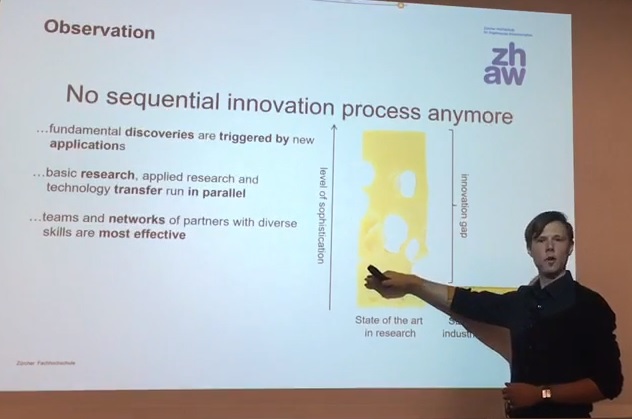SMEs and digitalization
What kind of digitalization support do SMEs need? This question was pondered on August 29 when Innosuisse assembled their experts, coaches, staff members and executives under the beautiful roof of CERN’s Globe of Science and Innovation for the Innosuisse Plenary 2018. The topic of innovation was omnipresent, and I had been invited as a representative of the Swiss Alliance for Data-Intensive Services to start the discussion in the breakout session on “digitalization and SMEs” with a keynote. I delivered some pointed hypotheses based on the experience of almost 2 years of Data+Service and numerous CTI/Innosuisse projects. A recording of the presentation is available online, together with the slides. The talk follows the important properties of digital innovations (namely, being interdisciplinary, aiming at automation at scale, and coming at a high speed). These are my conclusions, originally published on the Data+Service blog.
The size of an innovative idea does not need to match the size of the company pursuing it: thanks to the property of scalability, disruptive ideas for huge markets can even be implemented by start-up companies. That means: small and medium companies are not that different from larger enterprises when it comes to digital innovation - they can accomplish basically the same things. What is important for their success is the availability of an interdisciplinary network of experts to bring in the right advice and skill for actual R&D work, if this is required. The Swiss Alliance for Data-Intensive Services strives to be such a network.
Industry sector affiliation plays a decreasing role: as digital innovation is often driven by technology, a solid understanding and mastering of this technology within the innovation team is paramount. This can be brought in by an expert who does not need to have the same industry sector background as the business in need. For example, an expert in machine learning can build solutions for companies both in the production and financial sector, as similar challenges will likely arise; and for those companies involved, the interdisciplinary exchange with colleagues from other industries is likewise beneficial: same challenges, less competition amongst the involved parties, thus more open exchange.
Basic and applied research converge: due to the speed of innovation in the digital area, there is a huge gap between the amount of ideas that piled up in the academic sphere, and the comparatively little ideas that are actually used in businesses. However, this pile of ideas in research is not “solid”, so to say (see picture): as the speed of development for example in deep learning increases, not every aspect of each idea is thoroughly researched before somebody builds on top of it. This leads to the situation that in an applied research project, where a specific use case triggers research for a specific solution, the research team in their search through the idea pile eventually arrives at such a “hole”. This place is characterized by two properties: (a) the closeness of related publications shows that a solution to the actual case at hand might be feasible. An example for this might be a use case of industrial image processing for quality control, with the availability of research on deep learning for natural image processing with big training sets hinting at its likely success. However, (b) the hole shows that basic results (in the sense that they would be well received at a scientific conference on this topic, if discovered) that directly suit the properties of the given case are missing. To stay in the example, this might be work on deep learning with small training sets on technical images; it poses completely distinct research challenges not yet solved satisfactory also in the academic sector. An innovation project thus runs basic research, applied research and technology transfer effectively in parallel, rather than sequentially, as is proposed by some prevalent innovation funding schemes that try to aim at a specific link in that chain.

The Alliance is very well positioned to facilitate the kind of support for SMEs and other enterprises that is outlined in the three conclusions above: it provides a network of experts with diverse background and skills who are easily approachable. It takes care for interdisciplinary and parallel approaches to all necessary levels in the innovation process, from information to consulting and finally research. Moreover, it is committed (e.g., via its Expert Group on Data Ethics) to the fourth thing that must not be disregarded when talking about digitalization (or rather: digital transformation): that the main challenges ahead of us are non-technical, and need to be solved on a societal rather than an individual level.
